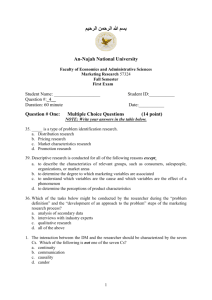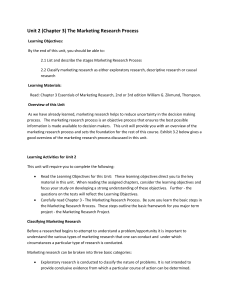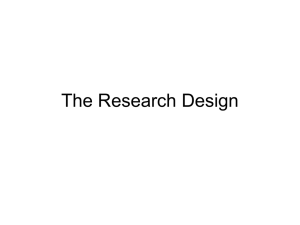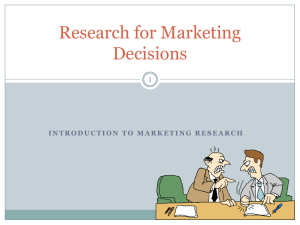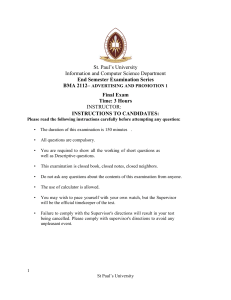Marketing Research and Market Intelligence
advertisement
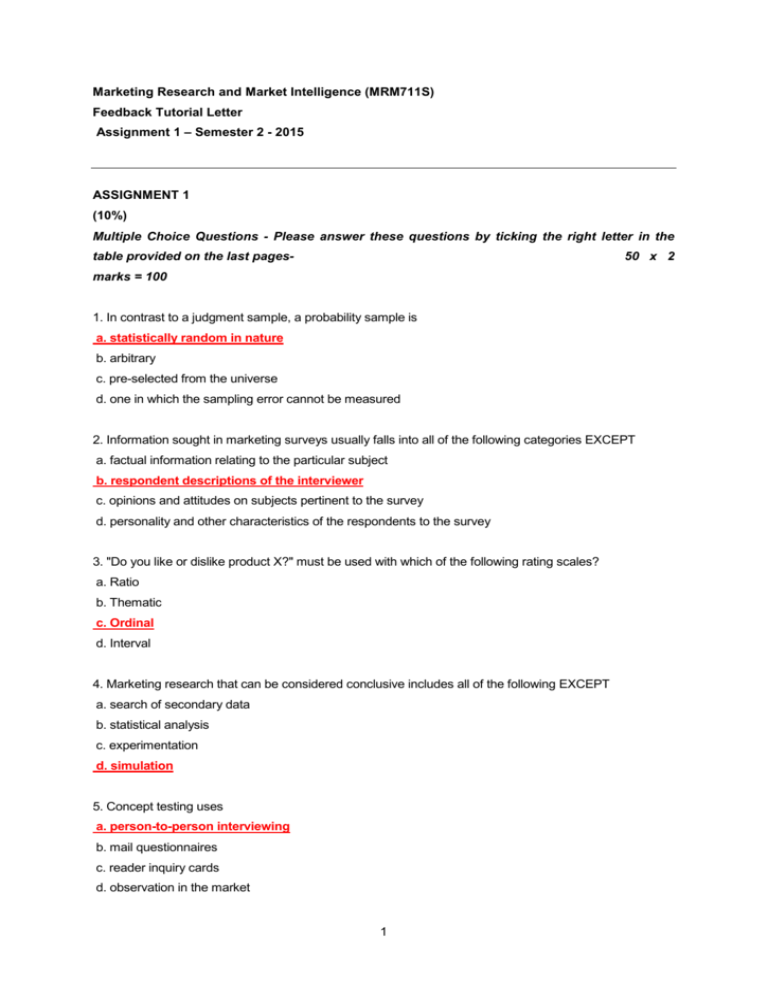
Marketing Research and Market Intelligence (MRM711S) Feedback Tutorial Letter Assignment 1 – Semester 2 - 2015 ASSIGNMENT 1 (10%) Multiple Choice Questions - Please answer these questions by ticking the right letter in the table provided on the last pages- 50 x 2 marks = 100 1. In contrast to a judgment sample, a probability sample is a. statistically random in nature b. arbitrary c. pre-selected from the universe d. one in which the sampling error cannot be measured 2. Information sought in marketing surveys usually falls into all of the following categories EXCEPT a. factual information relating to the particular subject b. respondent descriptions of the interviewer c. opinions and attitudes on subjects pertinent to the survey d. personality and other characteristics of the respondents to the survey 3. "Do you like or dislike product X?" must be used with which of the following rating scales? a. Ratio b. Thematic c. Ordinal d. Interval 4. Marketing research that can be considered conclusive includes all of the following EXCEPT a. search of secondary data b. statistical analysis c. experimentation d. simulation 5. Concept testing uses a. person-to-person interviewing b. mail questionnaires c. reader inquiry cards d. observation in the market 1 6. Distance traveled is a good example of a (n) a. interval scale b. nominal scale c. ordinal scale d. ratio scale 7. A survey conducted among 100 commercial airline pilots to determine the number of hours flown in a typical year produces a standard deviation of 240 hours. The standard error of the mean is a. 2.4 b. 4.8 c. 24 d. 48 8. The most popular technique for predicting values of one variable from values of another variable is a. analysis of variance b. linear regression c. correlation analysis d. coefficient of determination 9. A _________________ consists of people, equipment, and procedures to gather, sort, analyse, evaluate, and distribute needed, timely, and accurate information to marketing decision makers. a. management information system b. marketing information system c. financial information system d. management intelligence plan 10. Marketing information systems begin and end with information users. They _______________, develop needed information, and distribute information. a. assess information needs b. forecast problem situations c. gather marketing intelligence d. tighten internal security over information 2 11. In a marketing information system, it is necessary to develop needed information. All of the following would be primary sources of this needed information EXCEPT: a. psychoanalytical models. b. internal company databases. c. marketing intelligence. d. marketing research 12. A good marketing information system balances the information managers would like to have against: a. information that competitors have. b. information that is available. c. what they really need and what is feasible to offer. d. what is supplied by consultants. 13. One of the greatest problems in obtaining and accessing information that is relevant to a marketing manager is: a. the intelligence of the manager. b. the cost of obtaining the information. c. the number of people that are seeking the information. d. a cataloguing system for the information. 14. A(n) __________________ is a computerized collection of information obtained from data sources within the company. a. retrieval system b. marketing research report c. flow diagram and a PERT chart d. internal database 15. Information in the company database can come from many sources. Which of the following would not be chief among these sources? a. the accounting department b. the manufacturing department c. the marketing department d. interviews with stockholders 3 16. Which of the following information forms available to the marketing manager can usually be accessed more quickly and cheaply than other information sources? a. marketing intelligence b. marketing research c. customer profiles d. internal databases 17. . The goal of marketing intelligence is to: a. improve strategic decision making. b. improve external security of the organization. c. prevent regulators from persecuting the company or its officers. d. monitor employees and ensure the company against leaks or fraud. 18. The systematic design, collection, analysis, and reporting of data relevant to a specific marketing situation facing an organization is called: a. internal company records. b. marketing research. c. marketing implementation. d. marketing intelligence 19. The first step in the formal marketing research process is best described as being one where the marketing manager has to: a. define the problem and research objectives. b. interpret and report the findings. c. develop the research plan for collecting information. d. implement the research plan, and collect and analyse the data. 20. After the problem has been defined carefully, the next step in the marketing research process is to: a. develop the product concept. b. develop the advertising campaign. c. develop the research plan for collecting information. d. proceed with collecting the information. 21. ________________ is marketing research to gather preliminary information that will help define problems and suggest hypotheses. a. Descriptive research b. Causal research c. Exploratory research d. Experimental research 4 22. The type of research used to gather preliminary information to help generate research hypotheses is called: a. descriptive research. b. causal research. c. exploratory research. d. experimental research 23. ________________ is marketing research to better describe marketing problems, situations, or markets. a. Descriptive research b. Causal research c. Exploratory research d. Experimental research 24. The type of research used to describe things such as the market potential for a product is called: a. descriptive research. b. causal research. c. exploratory research. d. investigative research. 25. ___________________ is marketing research to test hypotheses about cause-and- effect relationships. a. Descriptive research b. Causal research c. Exploratory research d. Experimental research 26. The type of research used to test hypotheses about cause-and-effect relationships is called: a. descriptive research. b. causal research. c. exploratory research. d. investigative research. 27. The owner of a small men’s clothing store has noticed that sales for men’s suits are especially high on Saturdays and at the end of the month. If he chooses to investigate this phenomenon he would probably choose which of the following research formats? a. descriptive research b. causal research c. exploratory research d. investigative research 5 28. The second step of the marketing research process is ____________________. During this step an outline of sources of existing data, specific research approaches, contact methods, sampling plans, and instruments that researchers will use to gather new data are presented. a. defining the problem and research objectives b. implementing the research plan c. developing the research plan for collecting information d. interpreting and reporting the findings 29. Research objectives can be translated into specific information needs. Which of the following would not be a good example of such specific information needs that could be matched to research objectives as applied to consumers? a. demographic, economic, and lifestyle characteristics of users b. consumer-usage patterns c. profit margins d. attitudes toward proposed new packaging 30. __________________ is information that already exists somewhere, having been collected for another purpose. a. Experimental information b. External information c. Primary data d. Secondary data 31. _________________ is information collected for the specific purpose at hand. a. Experimental information b. External information c. Primary data d. Secondary data 32. The first type of data normally collected called____________________ data. a. experimental b. external c. primary d. secondary 6 and processed in a research effort is 33. All of the following are advantages of using secondary data EXCEPT: a. secondary data can be obtained from either internal or external sources. b. secondary data can be obtained more quickly than primary data. c. secondary data usually costs more (but is usually worth it) than primary data. d. secondary data can often provide data that an individual company cannot collect on its own. 34. Problems associated with secondary data include all of the following EXCEPT: a. consistency. b. relevancy. c. accuracy. d. current status (currency). 35. ________________ research is the gathering of primary data by observing relevant people, actions, and situations. a. Questionnaire b. Observational c. Survey d. Experimental 36. A wide range of companies now use ___________ research—which combines intensive observation with customer interviews—to gain deep insights into how customers buy and live with their products. a. experimental b. dyad c. ethnographic d. experimental 37. A people meter or a checkout scanner would be examples of which of the following forms of research? a. ethnographic b. survey c. experimental d. mechanical 38. ______________ is the gathering of primary data by asking people questions about their knowledge, attitudes, preferences, and buying behavior. a. Observational research b. Survey research c. Experimental research d. Mechanical research 7 39. The most widely used method for primary data collection is called: a. observational research. b. survey research. c. experimental research. d. mechanical research. 40. The major advantage of survey research is its: a. simplicity. b. structure. c. organization. d. flexibility. 41. ________________ is the gathering of primary data by selecting matched groups of subjects, giving them different treatments, controlling related factors, and checking for differences in group responses. a. Observational research b. Survey research c. Experimental research d. Mechanical research 42. When personal interviewing involves inviting six to ten people to gather for a few hours with a trained interviewer to talk about a product, service, or organization, the method is called: a. selective sponsorship. b. probing. c. focus group interviewing. d. the Delphi method. 43. When the researcher is using a _____________, each population member has a known chance of being included in the sample. a. sampling unit b. sample size measure c. probability sample d. nonprobability sample 8 44. When the sampling error cannot be calculated due to the method used to select the sample, the researcher has just used a(n): a. sampling unit sample. b. inverted sample. c. probability sample. d. nonprobability sample. 45. If the researcher (because of time or cost constraints) selects the easiest population members from which to obtain the information, he or she has just selected a(n): a. judgment sample. b. sample random sample. c. convenience sample. d. stratified random sample. 46. If the researcher is faced with a research problem wherein the population needs to be divided into mutually exclusive groups (such as age groups), and random samples are drawn from each group, the researcher has just selected a(n): a. judgment sample. b. sample random sample. c. convenience sample. d. stratified random sample. 47. If every member of the population has a known and equal chance of being chosen to survey, then the researcher has just used a(n): a. judgment sample. b. sample random sample. c. convenience sample. d. stratified random sample. 48. ____________________ include all the possible answers, and subjects make choices among them. a. Closed-parameter questions b. Open-end questions c. Closed-end questions d. Conditioned response questions 9 49. If a researcher wanted to measure a respondent’s physical responses with a mechanical device, he or she could use a (n): a. galvanometer. b. people meter. c. scanner. d. brain probe. 50. One common misuse of marketing research findings in contemporary business is the tendency for marketing research to: a. become a vehicle for pitching the sponsor’s products. b. become a vehicle for discriminating in the marketplace. c. become a means for raising prices. d. become a means for unfair competition. 10
